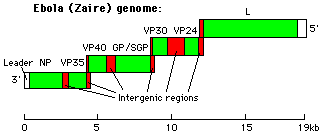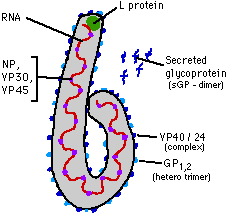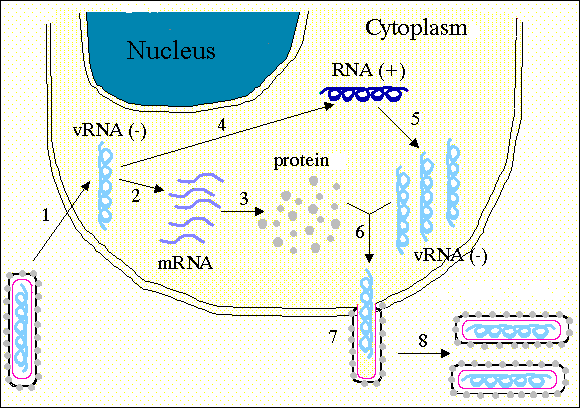Family: Filoviridae
(1) Genus: Marburgvirus
Species:
(a) Lake Victoria marburgvirus
(2) Genus: Ebolavirus
Species:
(a) Ivory Coast ebolavirus
(b) Reston ebolavirus
(c) Sudan ebolavirus
(d) Zaire virus
![]() Taxonomy
Taxonomy
Family: Filoviridae
(1) Genus: Marburgvirus
Species:
(a) Lake Victoria marburgvirus
(2) Genus: Ebolavirus
Species:
(a) Ivory Coast ebolavirus
(b) Reston ebolavirus
(c) Sudan ebolavirus
(d) Zaire virus
![]() Genome
Genome
single-stranded RNA
negative polarity
linear
monopartite (non-segmented)
19,000 nucleotides long
Nucleotide sequences of 3'-terminus complementary to similar regions on the 5' end
not capped
19.1 kilobases

http://www-micro.msb.le.ac.uk/3035/Filoviruses.html
![]() Capsid
Capsid
enveloped
helical symmetry
long, filamentous shape (hence "filo")
envelope contains glycoprotein spikes
![]() Proteins
Proteins
Filoviruses produce seven proteins, including RNA dependent RNA polymerase (L), nucleocapsid protein (NP), two forms of
glycoprotein (GP), four glycosylated viral proteins (VP40, VP35, VP30 and VP24[in Marburg])

http://www-micro.msb.le.ac.uk/3035/Filoviruses.html
![]() Replication
Replication
Replication takes place in the cytoplasm of host cells when the virion removes its coat and uses its own transcriptase to
transcribe its -ssRNA into the complimentary +ssRNA. Regarding transcription, the mRNAs are monocistronic,
polyadenylated and uncapped. One genomic and six subgenomic positice
sense mRNAs correspond to each of the structural proteins. Eventually, high concentrations of replicated viral
genomes begin to appear, marked by the formation of large inclusion bodies with maturation occurring through budding from the
plasma membrane.
Filovirus translation may involve Internal Ribosome Entry Sites (IRES), and appears to violate Kozak's rules.

http://www.stanford.edu/group/virus/filo/class.html